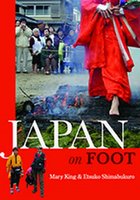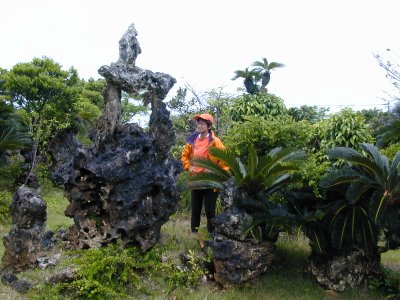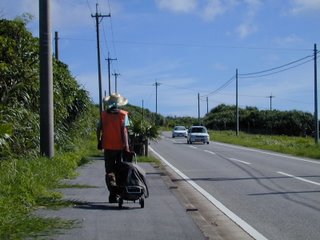
2001/2002
IT TOOK four days of traipsing through intense heat to reach Shuri City, where Etsuko was born and raised. The muggy heat took an incredible toll on us during the stretch from Motobu town to Etsuko’s hometown, but there was much to absorb and enjoy en route to the city where the Kings of Okinawa once resided. A habu snake show, as well as walking past U.S. military bases where planes flew so low we would actually duck in fear that they were about to land on us, were just a few of the roadside entertainments that kept us on our toes. Sweat dripped from every pore, soaking our clothes, and we found ourselves stopping to grab drinks from vending machines at virtually every fifteen-minute interval. Mama-chan simply laughed and shrugged as her daughter stepped over the threshold for the first time in 10 years. Etsuko’s mother, who I had previously met at one of her son’s weddings in Tokyo, backed off as I went to hug and kiss her on the cheek. “No, no, no!” she screamed, waving me off like I were a monster yet at the same time revealing she had a mouth full of jet-black teeth. It was my turn to be horrified. “Good God!” I screeched. I had never seen such deteriorated teeth. Etsuko laughed. “Mom’s rustled up an Okinawan speciality; squid ink soup,” she tittered, leading me into the kitchen to show off a pot full of what looked like burning coal and petroleum. A few hours later, we all sat around laughing and chatting with teeth and tongues as terrifying as those of the Hindu goddess Kali. Mama-chan regaled me with tales about shamanesses and clairvoyants, as well as her own experiences with studying palmistry. Apparently, she was a born natural, according to her teacher. “This line on my hand here, I’m told, is very unusual. It seems that I was [warrior leader] Tokugawa Ieyasu in a previous life,” she earnestly told me. I shivered at the prospect. I presented her my palm and she scrutinized it carefully. “You don’t have any problems to make a living,” she proffered, and then a few minutes later added, “Look, if you can’t sell your book, both of you can live with me in Okinawa.”Mama-chan went on to explain that she believes palmistry, as well as the utterings of shamanesses, to be largely a load of bunkum. “I’m not superstitious at all,” she insisted, but three days later when Etsuko and I were ready to depart for Miyako Island, she suddenly presented me with a bag of salt. I was stumped. Was this some kind of Okinawan ritual that Etsuko had forgotten to mention? “The salt is for protection,” Mama-chan told me, throwing another bag at her daughter. “Come back here before Festival of the Dead; it’s dangerous to be traveling when the dead are walking around,” she warned. We sailed for Miyako Island, where I hoped to meet with a man who has devoted twenty years of his life to digging up huge rocks in his garden, apparently for spiritual purposes. The Hiryu sailed into the island at the unearthly hour of 4 a.m., leaving the two of us with no choice but to sleep out in the streets until the island awoke and shifted into gear for life and work. We took a bleary-eyed breakfast at Mos Burger, in Hirara City, where I was tickled pink to spot a handwritten sign that announced, “We are sorry, but it will rain a lot over the next few days. We have recently performed our rain dance.” Mr. Sadakichi Shinjo was not in the best of spirits when we met him. He was annoyed because we had turned up five minutes early while the eighty-year-old was in the midst of his lunch. Returning to his rice and fish, the old chap left Etsuko and me to sit in a room that was adorned with hundreds of strange-looking, coral-like rocks that, since 1980, he has dug up from his garden. After his meal, Mr. Shinjo ordered us to explore his garden on our own, and so Etsuko and I found ourselves clambering through a mini-jungle of banana trees, palms and lichen-covered rocks, until we fell upon what appeared to be the lost city of the Incas. Rocks of every size imaginable had been placed in groups here and there, and I felt both an essence of sanctity and the hand of a great artist at work. The coral-like stones were truly magnificent, arranged artistically, and bearing prayers and proverbs. Mr. Shinjo, however, was not impressed to hear that I considered him an artist. It definitely set the interview off on a wrong footing. The scrawny man with bushy grey hair was used to having people treat him like a guru. Didn’t I know that people came to him, clasping hands together and bowing in worship, in the hope that he would bless them and pass on his super-human strength. “Even athletes have come asking me to give them strength,” he warned us. Perhaps he was disappointed that neither of us was seeking out his blessings; he obviously felt that we weren’t sufficiently in awe of him.

We had seen the huge holes in his garden, from where he digs his rocks, and I found it rather incredible that this small man could have lifted rocks?some of them weighing ten tons?alone. “Do you use some kind of digger,” I asked. Mr. Shinjo was now well and truly miffed by us. “This strength was given to me. It came after a dream when I was forty-seven. I was told that I needed to teach men about

His family had moved to the main Okinawan Island and left him to pursue his dream, but it seemed that he had become bitter. “My powers have now left me. I don’t have the strength anymore to dig for rocks. The rocks no longer speak to me and it’s no longer fun,” he snapped at us. Etsuko and I decided it was perhaps best to leave Mr. Shinjo to his own devices. He looked sad when we shook his hand and bid him well, but it was time for us to move on. Our next stop would be Hateruma Island, Japan’s southernmost inhabited point.


2 comments:
your opinion is sooo American...by the way, are you American?
No, I'm definitely not American. I'm not South American or North American. Curious as to what in particular I wrote here that is '"sooo American" but I'm guessing that it might not matter where you're from you can always find someone who agrees or disagrees with you. Anyway, thanks for visiting the site. I hope you'll enjoy the book. Best wishes.
Post a Comment